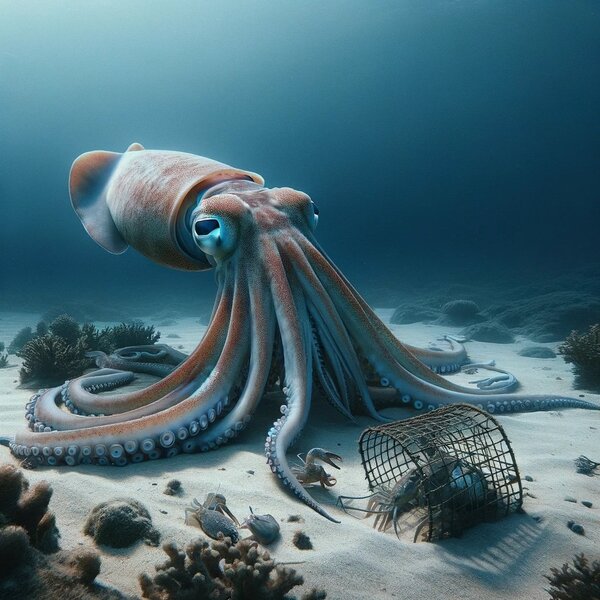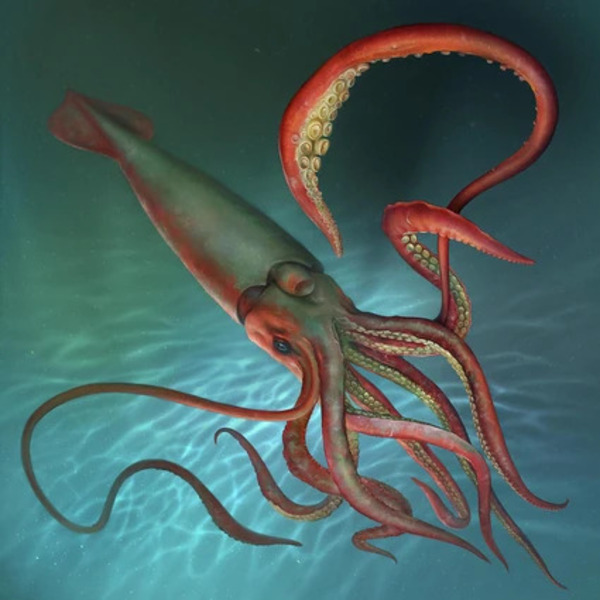When it comes to the mysteries of the ocean, few creatures capture our imagination quite like the giant squid. These elusive giants have been the stuff of legends for centuries, but how big can they really get? In this article, we'll explore the biggest squid ever found, its characteristics, habitat, and the fascinating science behind these incredible aquarium/52-marine-animals.html">marine animals.

The giant squid, scientifically known as Architeuthis dux, is one of the largest mollusks in the world. They are known for their impressive size, with some specimens reaching lengths of up to 43 feet (13 meters) or more, including their long tentacles. While they were once thought to be mythical creatures, modern science has uncovered much about their biology and behavior.
In 2007, a team of researchers from New Zealand made headlines when they discovered what is believed to be the biggest squid ever found. This colossal creature measured approximately 13 feet (4 meters) in body length, but when its long tentacles were included, the total length reached around 40 feet (12 meters). This remarkable specimen was caught on film in its natural habitat, providing invaluable insights into the life of the giant squid.

Size: As mentioned, giant squids can grow to impressive lengths. While the average size ranges from 30 to 43 feet (9 to 13 meters), there are reports of even larger specimens.
Anatomy: Giant squids have a streamlined body, large eyes (the largest of any animal), and eight arms lined with suckers. Their long tentacles are used for catching prey, which mainly consists of fish and other squid.
Color and Camouflage: These squids can change color and texture, allowing them to blend into their surroundings. This ability helps them evade predators and ambush prey.
Habitat: Giant squids inhabit deep ocean waters, typically at depths of 1,000 to 3,000 feet (300 to 900 meters). Their elusive nature makes them difficult to study, and much of what we know comes from specimens washed ashore or captured in rare underwater footage.
Despite their size, giant squids are rarely seen by humans. They are deep-sea creatures, making them difficult to study in their natural environment. Much of our understanding comes from anecdotal evidence and the occasional sighting. For years, fishermen reported sightings of massive squids, leading to tales of sea monsters lurking in the depths.
Advancements in technology have allowed scientists to study giant squids more effectively. In recent years, underwater cameras and submersibles have captured footage of these creatures in their natural habitat, providing insights into their behavior and ecology. Research has also focused on their reproductive habits, feeding strategies, and interactions with other marine life.

The giant squid (Architeuthis dux) is an intriguing creature that plays a significant role in the oceanic ecosystem. Understanding its diet and natural predators provides insight into its life and survival strategies.
Carnivorous Diet:
Giant squids are carnivorous and primarily feed on a diet consisting of fish, smaller squid, and crustaceans. Their impressive size and predatory skills make them formidable hunters in the deep sea.
Hunting Techniques:
Ambush Predation: Giant squids use their long, flexible tentacles to ambush prey. They can swiftly extend their tentacles to grasp unsuspecting fish or smaller squid, pulling them in for a meal.
Suction Cups: The tentacles are lined with suckers, which help them hold onto their prey securely. Some species of giant squids have been observed using their beaks to tear flesh, similar to the way birds eat.
Feeding Behavior:
Giant squids are known to be opportunistic feeders. They may consume whatever prey is available in their environment, adjusting their hunting strategies based on the availability of food sources.
They often hunt at night, utilizing the cover of darkness to stalk their prey.

Sperm Whales:
The most significant predator of the giant squid is the sperm whale (Physeter macrocephalus). These massive marine mammals are known for diving deep into the ocean to hunt for giant squids. Sperm whales have been documented with giant squid remains in their stomachs, showcasing their role as a natural predator.
Other Marine Animals:
While sperm whales are the primary threat, other predators in the ocean may also target giant squids, particularly when they are young or smaller in size. These can include larger fish and other squid species.
Sea lions and certain types of sharks may also opportunistically prey on smaller or injured giant squids.
Environmental Challenges:
Aside from biological predators, giant squids face challenges from their environment, including changes in water temperature, pollution, and habitat destruction, which can impact their food sources and overall health.
The giant squid is a fascinating predator in its own right, feeding on a variety of marine life using effective hunting techniques. However, it is also part of a larger food web, with sperm whales being its most notable predator. Understanding these dynamics helps highlight the ecological role of the giant squid and the delicate balance of life in the deep ocean.
The giant squid is a remarkable creature that continues to fascinate scientists and the public alike. The biggest squid ever found is a testament to the wonders of the ocean and the mysteries that still remain. As technology continues to evolve, we may uncover even more about these elusive giants of the deep. Whether you're a marine enthusiast or simply curious about the natural world, the giant squid serves as a reminder of the extraordinary life that thrives beneath the ocean's surface.

The battle between the sperm whale (Physeter macrocephalus) and the giant squid (Architeuthis dux) has intrigued scientists and ocean enthusiasts alike. Both creatures are fascinating in their own right, but when it comes to a confrontation between these two deep-sea giants, who would come out on top? Let’s explore their characteristics, hunting strategies, and the dynamics of their interactions.
Size:
Sperm whales are the largest toothed predators on Earth, with males reaching lengths of up to 60 feet (18 meters) and weighing as much as 45 tons. Their massive size gives them a significant advantage in strength and power.
Diet:
Sperm whales primarily feed on squid, including giant squids. They are deep divers, capable of reaching depths of over 3,000 feet (900 meters) in search of food.
Hunting Techniques:
Sperm whales use echolocation to locate prey in the dark depths of the ocean. They often hunt in groups, using cooperative strategies to capture their prey.
Social Behavior:
These whales are social animals, often found in pods. Their social structure can aid in hunting, as they can work together to corner and capture prey.
Size:
Giant squids can grow up to 43 feet (13 meters) or more, making them one of the largest mollusks. However, they are generally lighter than sperm whales.
Diet:
Giant squids are carnivorous, feeding on fish and smaller squids. Their role as predators allows them to evade larger threats in their environment.
Hunting Techniques:
Giant squids rely on ambush tactics, using their long, flexible tentacles lined with suckers to catch prey. They are also capable of rapid movements to escape danger.
Camouflage and Defense:
These squids can change color and texture to blend into their surroundings, helping them avoid detection by predators.
Predator vs. Prey:
In a direct encounter, the sperm whale is the predator, while the giant squid is its prey. Sperm whales have evolved to hunt and consume giant squids, making them highly adept at overcoming these creatures.
Strength and Size:
The sheer size and strength of the sperm whale give it a significant advantage. A sperm whale's powerful jaw and large body can easily overpower a giant squid.
Intelligence and Social Hunting:
Sperm whales are highly intelligent and capable of coordinated group hunting. This social behavior increases their chances of successfully capturing a giant squid.
Survival Strategies:
While giant squids possess impressive defense mechanisms, such as camouflage and rapid escape, they are generally no match for the hunting prowess of a sperm whale.
In the battle between the sperm whale and the giant squid, the sperm whale is likely to emerge as the victor. Their size, strength, and hunting strategies make them formidable predators in the ocean. However, this dynamic also highlights the intricate balance of life in the deep sea, where both creatures play essential roles in the marine ecosystem. While sperm whales may be the dominant force, the giant squid remains an impressive and mysterious creature of the ocean.
When comparing the giant squid (Architeuthis dux) and the colossal squid (Mesonychoteuthis hamiltoni), two of the largest cephalopods in the ocean, several factors come into play regarding their aggressiveness and bite force. Below is a detailed analysis and comparison.
| Feature | Architeuthis dux (Giant Squid) | Mesonychoteuthis hamiltoni (Colossal Squid) |
|---|---|---|
| Size | Up to 43 feet (13 meters) | Up to 46 feet (14 meters) |
| Weight | Up to 600 pounds (272 kg) | Up to 1,000 pounds (450 kg) |
| Habitat Depth | 1,000 - 3,000 feet (300 - 900 m) | 3,000 - 7,000 feet (900 - 2,100 m) |
| Diet | Fish, smaller squid | Fish, smaller squid, and other aquarium/52-marine-animals.html">marine animals |
| Bite Force | Moderate (exact force not well-studied) | High (estimated to be stronger due to larger beak) |
| Aggressiveness | Moderate; tends to ambush prey | High; aggressive hunting tactics |
| Predators | Sperm whales, larger fish | Sperm whales, larger fish |
Architeuthis dux: The giant squid is generally considered a more elusive predator. It employs ambush tactics, waiting for the right moment to strike its prey. While it can be aggressive when hunting, it tends to avoid confrontation unless necessary.
Mesonychoteuthis hamiltoni: The colossal squid is known for its aggressive hunting style. It has been observed engaging in battles with predators, including sperm whales. Its size and powerful limbs make it a formidable opponent in the ocean.
Architeuthis dux: The bite force of the giant squid is moderate, but precise measurements are not well-documented. Its beak is strong enough to tear flesh, allowing it to consume prey effectively.
Mesonychoteuthis hamiltoni: The colossal squid likely has a higher bite force due to its larger size and stronger beak. It is adapted to hunt larger prey, which suggests a greater need for a powerful bite.
In summary, while both species exhibit unique adaptations and hunting strategies, the colossal squid (Mesonychoteuthis hamiltoni) is generally considered more aggressive and likely possesses a stronger bite force compared to the giant squid (Architeuthis dux). The colossal squid’s size and aggressive nature make it a formidable predator in the deep sea, while the giant squid’s ambush tactics allow it to be a successful hunter as well. Understanding these characteristics highlights the fascinating dynamics of life in the ocean's depths.
animal tags: Squid
We created this article in conjunction with AI technology, then made sure it was fact-checked and edited by a Animals Top editor.